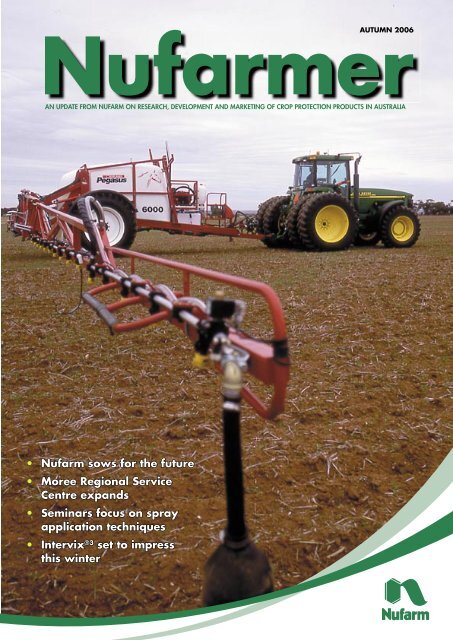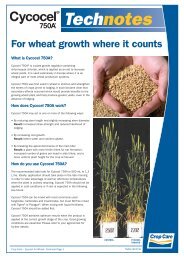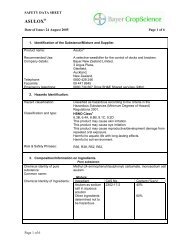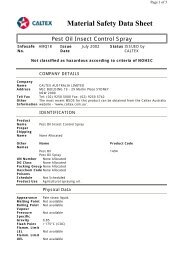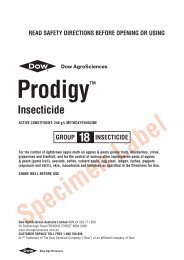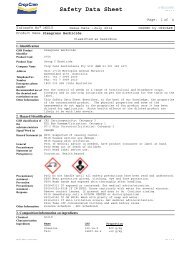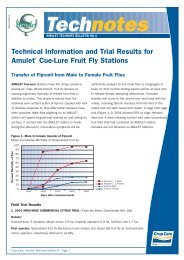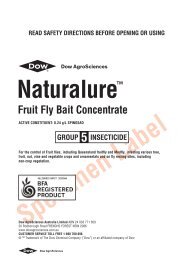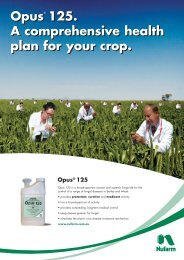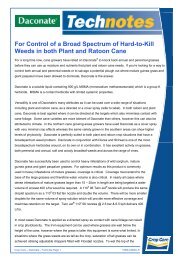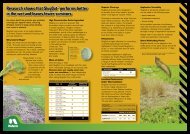Nufarmer 2006 Autumn - Pest Genie
Nufarmer 2006 Autumn - Pest Genie
Nufarmer 2006 Autumn - Pest Genie
You also want an ePaper? Increase the reach of your titles
YUMPU automatically turns print PDFs into web optimized ePapers that Google loves.
AUTUMN <strong>2006</strong><br />
<strong>Nufarmer</strong><br />
AN UPDATE FROM NUFARM ON RESEARCH, DEVELOPMENT AND MARKETING OF CROP PROTECTION PRODUCTS IN AUSTRALIA<br />
• Nufarm sows for the future<br />
• Moree Regional Service<br />
Centre expands<br />
• Seminars focus on spray<br />
application techniques<br />
• Intervix ®3 set to impress<br />
this winter<br />
<strong>Nufarmer</strong> <strong>Autumn</strong> <strong>2006</strong><br />
1
Welcome<br />
Contents<br />
For more than 50 years Nufarm has<br />
been supporting Australian agriculture<br />
by developing new products and uses<br />
and expanding our service network.<br />
Nufarm is an Australian-owned<br />
company, committed to quality products<br />
designed for and tested in Australian<br />
conditions. No other supplier of crop<br />
production products can claim this fact.<br />
In this issue we reinforce the messages<br />
outlined in the current advertising<br />
campaign. In this campaign, Nufarm<br />
reminds growers of the value we deliver,<br />
ensuring farmers get the best outcomes<br />
when they choose Nufarm products.<br />
When you’re farming, timing is<br />
everything. When the spray window is<br />
open, farmers need to work quickly to<br />
maximise cropping yields. To help farmers<br />
get products delivered quickly, Nufarm has<br />
made significant investments in its service<br />
network. The latest expansion is at the<br />
Moree Regional Service Centre (see page<br />
5). Crop protection products stored closer<br />
to the paddock ensure rapid delivery times.<br />
Nufarm provides so much more than a<br />
drum of chemical. Nufarm is committed to<br />
efficacious spray application and holds<br />
regular demonstrations and workshops for<br />
our re-sellers, farmers and agronomists<br />
(see page 4/5).<br />
Seeds are quickly being regarded as the<br />
engine room of agricultural production.<br />
Nufarm has an expanding seeds division<br />
that is bringing exciting new varieties to<br />
market for better yields and greater returns<br />
for farmers.<br />
Nufarm develops new products for the<br />
market every year. In this issue are details<br />
of the new Intervix ®3 herbicide and new<br />
uses for Penncozeb ®5 420SC fungicide.<br />
This season, more than ever, farmers<br />
should insist on Nufarm. Anything else is<br />
just UnAustralian.<br />
Darren Thomas<br />
Brand Manager<br />
Nufarm Australia Limited<br />
3 Nufarm sows for the future<br />
4 Why farmers should insist on Nufarm<br />
5 Upgrade for Moree Regional Service Centre<br />
6-7 News from Croplands, your crop protection<br />
equipment specialists<br />
8 Opus 125 gives the best stripe rust control in<br />
dryland wheat<br />
9 Monza: your flexible choice for brome<br />
and barley grass control<br />
10 Herbicide mixtures effective against resistant<br />
annual ryegrass<br />
11 News in horticulture<br />
®/ Registered/trademarks of Nufarm Australia Limited<br />
® 1 Registered trademark of Nufarm Technology USA Pty Ltd.<br />
® 2 Registered trademarks of Monsanto Technologies LLC, used under<br />
license by Nufarm Australia Limited.<br />
® 3 Registered trademarks of BASF, used under licence by Nufarm<br />
Australia Limited<br />
® 4 Registered trademark of Spraying Systems Co, USA.<br />
® 5 Registered trademark of Cerexagri SA.<br />
® 6 Registered trademark of Syngenta.<br />
Cover: Croplands’ 6000 L Pegasus Sprayer is purpose-built for easy and efficient broadacre spraying.<br />
2 <strong>Nufarmer</strong> <strong>Autumn</strong> <strong>2006</strong>
Nufarm Plant Science<br />
– sowing for the future<br />
Nufarm has a highly skilled domestic and international plant breeding and field operations team, based in Horsham, Finley and Yarck in<br />
Victoria and offshore. This aerial photograph shows the plant breeding operation on Dahlen Quarry Road near Horsham, Victoria.<br />
In the past 12 months Nufarm has<br />
consolidated its interests in plant<br />
breeding and development with the<br />
acquisition of Victorian canola breeder,<br />
Ag-Seed Research Pty Ltd.<br />
Nufarm, under the banner of Nufarm<br />
Plant Science, now owns three plant<br />
breeding and development businesses -<br />
Nugrain Pty Ltd, Ag-Seed Research Pty<br />
Ltd and Access Genetics Pty Ltd.<br />
The company and its partners are<br />
involved in breeding and developing<br />
new wheat, barley, canola, oats and<br />
field pea varieties. Nufarm now has a<br />
significant germplasm base and a highly<br />
skilled domestic and international plant<br />
breeding and field operations team,<br />
based in Horsham, Finley, Yarck and<br />
offshore.<br />
“This is an exciting move for Nufarm in<br />
delivering the biology and chemistry to<br />
Australian farmers and in the mediumterm<br />
progressing developments<br />
internationally,” said Barry Cox, General<br />
Manager of Nufarm Plant Science.<br />
“Nufarm, through its subsidiary<br />
companies and licensing arrangements,<br />
is actively involved in the development<br />
and release of many of the new, elite<br />
canola varieties now available to<br />
Australian growers,” he said.<br />
“These include ATR Banjo ,<br />
ATR-Summitt , Bravo TT and Warrior<br />
CL .<br />
“Nufarm plans to continue to release<br />
new canola varieties.”<br />
Through Access Genetics Pty Ltd,<br />
Nufarm has established relationships<br />
with SW Seeds and World Wide Wheat.<br />
Both companies have access to new and<br />
diverse germplasm pools not previously<br />
available to Australian growers.<br />
After five years of breeding and<br />
development work with these partners,<br />
Access Genetics Pty Ltd will offer a<br />
range of new plant varieties to Australian<br />
growers in <strong>2006</strong>/2007.<br />
This will include a range of high<br />
yielding, high quality field peas and new<br />
wheat, barley and oat varieties. Many of<br />
these varieties are already in public trials<br />
and showing excellent results.<br />
<strong>2006</strong> varieties<br />
Variety Description Marketed by<br />
ATR Banjo<br />
A new early maturity, TT canola<br />
with very high oil yields and a<br />
blackleg rating of 7<br />
ATR-Summitt New mid maturity TT canola Dovuro<br />
Ag-Seed Research<br />
Bravo TT New mid TT canola PlantTech<br />
SW Odiel Wheat<br />
Tickit Triticale<br />
Warrior CL<br />
Early maturity, strong rust<br />
resistant wheat<br />
Tahara replacement with<br />
excellent rust and CCN<br />
resistance<br />
New mid-late maturity IMI<br />
variety<br />
“Nufarm is always seeking ways to do<br />
things better,” said Mr Cox.<br />
“The way new plant varieties have<br />
historically been delivered to farmers can<br />
and will change over time,” he said.<br />
“Nufarm expects to be at the forefront<br />
of these changes.”<br />
The products denoted by this symbol<br />
are registered under Plant Breeders Rights<br />
(PBR) in Australia. Unauthorised commercial<br />
propagation or any sale, conditioning, export,<br />
import or stocking of propagating material is an<br />
infringement under the Plant Breeders Rights Act<br />
(1994). Any breach of this legislation will leave<br />
the grower liable for prosecution.<br />
Access Genetics<br />
Nugrain<br />
PlantTech<br />
Seeds of these varieties should be available through major distribution outlets,<br />
however, some stocks are limited.<br />
Enquiries can be directed to Barry Cox on mobile: 0409 374 383.<br />
<strong>Nufarmer</strong> <strong>Autumn</strong> <strong>2006</strong><br />
3
Nufarm committed to local<br />
R&D and manufacturing<br />
“Good advice is just as important as<br />
the product in getting the job done right<br />
the first time. Nufarm has a support<br />
network of 29 Territory Managers and<br />
five Horticulture Managers based in key<br />
crop protection zones in five states to<br />
support farmers’ decisions in the<br />
paddock. We’ve got the resources to get<br />
the job done and done well.”<br />
Darren Thomas, Brand Manager, said<br />
research had shown a groundswell of<br />
consumer support for Australian-made<br />
products and services.<br />
“Consumers are keen to support<br />
Australian products, particularly if they<br />
are high quality and available at the<br />
right price,” said Mr Thomas.<br />
Nufarm has stressed its commitment to investing in local research and development in current<br />
press and television advertisements featuring the slogan: “Insist on Nufarm. Anything else is<br />
just UnAustralian.”<br />
Farmers who want to choose quality<br />
Australian crop protection products<br />
and services need look no further<br />
than Nufarm.<br />
Nufarm supports Australian farmers<br />
through local manufacturing and<br />
infrastructure investment, timely product<br />
supply and local research and<br />
development into new products and uses.<br />
That’s the theme of the current Nufarm<br />
advertising campaign launched in<br />
February.<br />
According to National Marketing<br />
Manager, Peter Crock, Australian-owned<br />
Nufarm continues to invest heavily in its<br />
own backyard with:<br />
• four major Australian<br />
manufacturing facilities – in<br />
Laverton, Kwinana, Welshpool and<br />
Brendale, employing more than<br />
300 people,<br />
• nine Regional Service Centres<br />
situated in prime farming areas<br />
across the country, and<br />
• more than $10 million spent<br />
annually on research and<br />
development in the laboratory and<br />
in field trials on Australian farms.<br />
“Nufarm is proudly Australian. For<br />
more than 50 years we’ve worked with<br />
Australian farmers to provide a wide<br />
range of top quality crop protection<br />
products,” said Mr Crock.<br />
“Australians are regarded as<br />
resourceful, hardworking, loyal and<br />
trustworthy. Nufarm also holds these<br />
values which ref lect the service<br />
philosophies and successes of our<br />
founder, Max Fremder,” he said.<br />
“Nufarm has done the hard yards in<br />
the paddock, running extensive field<br />
trials to develop new products and uses<br />
for tough Australian conditions in<br />
recognition that imported formulations<br />
are often designed for European<br />
conditions.<br />
“No other crop protection company in<br />
Australia has the manufacturing<br />
capability of Nufarm to back up our<br />
research. We’re proud to keep<br />
manufacturing jobs and profits in<br />
Australia.<br />
“We’re able to respond more rapidly<br />
than other companies to peak farming<br />
demand by building our Regional<br />
Service Centres in the best places to<br />
serve agriculture. Our expansion<br />
program continues.<br />
“We know Australian farmers want to<br />
support local industry because together<br />
we’re creating a better future for<br />
agriculture in this country. Choosing<br />
products from overseas companies would<br />
be just unAustralian.”<br />
Spraywise semi<br />
More than 700 farmers and<br />
agronomic advisors have<br />
heard and seen ways to<br />
reduce off-target spray drift at 19<br />
spray application workshops held by<br />
Nufarm in the past four months.<br />
The workshops were conducted as<br />
part of the company’s Spraywise ®<br />
program and were well received,<br />
according to the co-ordinator, Jorg Kitt.<br />
Nufarm introduced the Spraywise<br />
program last year to significantly<br />
reduce the incidence and risk of spray<br />
drift damage to a diversity of crops<br />
without compromising spraying efficacy.<br />
The workshops were designed to<br />
look at the drift problem from all<br />
angles – the role of chemicals used,<br />
inf luence of nozzle choice and<br />
set-up of machinery, impact of<br />
weather and governing legislation.<br />
4 <strong>Nufarmer</strong> <strong>Autumn</strong> <strong>2006</strong>
Moree Regional<br />
Service Centre<br />
upgraded<br />
Nufarm is in a strong position to<br />
meet expected growth in<br />
demand for its range of preemergent<br />
crop protection products in<br />
<strong>2006</strong>, following further investment in its<br />
Regional Service Centre network.<br />
A new 1,000 square metre warehouse<br />
has been completed at the Moree<br />
Regional Service Centre, bringing the<br />
number of warehouses on site to three.<br />
In addition, three new 30,000 litre onsite<br />
bulk tanks will offer refills of Roundup<br />
PowerMAX ®2 and Roundup ®2 CT.<br />
The upgrade anticipates increased<br />
demand for f lagship pre-emergent<br />
brands – Roundup PowerMAX, Avadex ®1<br />
Xtra and Trif lurX ® – in the run-up to the<br />
winter broadacre cropping season.<br />
Moree is the latest in a series of<br />
upgrades that has seen expanded<br />
facilities at the Wagga Wagga and<br />
Dubbo Regional Service Centres.<br />
A brand new facility also opened at<br />
Geraldton in WA last year. More<br />
Regional Service Centres are planned as<br />
Nufarm continues to invest in Australian<br />
agriculture by providing up-to-date<br />
facilities offering the full Nufarm product<br />
range at shorter delivery times.<br />
Nufarm now has nine state-of-the-art<br />
Regional Service Centres in prime<br />
farming districts throughout Australia to<br />
serve its resellers, reinforcing its position<br />
as the only Australian-owned<br />
manufacturer with an extensive service<br />
network in rural Australia.<br />
“The company’s goal is to supply our<br />
products to resellers in a turnaround time<br />
unmatched by any other crop protection<br />
supplier,” said Matt Sargent, Commercial<br />
Development Manager.<br />
Bruce McGowan of Nufarm stores pallets<br />
inside the new warehouse in readiness for<br />
the <strong>2006</strong> winter cropping season.<br />
“No other agricultural chemicals<br />
supplier in Australia has as broad a<br />
network of Regional Service Centres as<br />
Nufarm. We are proud to be Australianowned<br />
and to serve Australian<br />
agriculture as efficiently as possible,”<br />
said Mr Sargent.<br />
nars – managing spray drift<br />
Consultant for weather services,<br />
Graeme Tepper, presented informative<br />
insights into the complexity of local<br />
weather predictions.<br />
“Mr Teppert explained<br />
microclimates at ground level<br />
and how inversion layers form<br />
and how they can affect<br />
spraying operations,” said Mr<br />
Kitt.<br />
Richard Warner and Frank<br />
Taylor from the R&D team at<br />
Nufarm, differentiated phenoxy Jorg Kitt<br />
products according to their<br />
volatility and explained differences<br />
between vapour drift and physical<br />
droplet drift.<br />
“A very popular part of the workshop<br />
was the hands-on demonstration<br />
provided by spray application consultant,<br />
Bill Gordon,” said Mr Kitt.<br />
“He demonstrated visually how<br />
nozzles producing a coarser spray<br />
quality were less affected by drift.”<br />
Senior Chemical Standards<br />
Officers presented at the<br />
workshops and discussed new<br />
legislation such as the<br />
extension to chemical control<br />
areas in Victoria and new<br />
legislation stipulating phenoxy<br />
products must be sprayed with<br />
nozzles that produce a<br />
COARSE to VERY COARSE<br />
spray quality.<br />
“The Spraywise workshops were an<br />
excellent example of how Nufarm can<br />
pull industry resources together and<br />
apply its knowledge to provide viable<br />
information and a service of relevance<br />
to the farming community,” said Mr Kitt.<br />
• Nozzles producing a FINE spray<br />
quality such as the TeeJet ®4 XR11002<br />
markedly increase drift potential<br />
compared to a COARSE spray<br />
quality.<br />
• Most spray operations in the field<br />
allow a change to nozzles that provide<br />
a coarser spray quality without the<br />
risk of losing efficacy.<br />
• Highly volatile phenoxy formulations<br />
such as Estercide ® 800 should<br />
mainly be used in colder winter<br />
months and not in proximity to<br />
sensitive crops.<br />
• Only non-volatile phenoxy products<br />
such as Surpass ® 300 should be<br />
used in warmer spring and summer<br />
months or in close proximity to<br />
sensitive crops.<br />
• New legislation requires all phenoxy<br />
herbicides to be applied with<br />
nozzles producing a COARSE to<br />
VERY COARSE spray quality.<br />
<strong>Nufarmer</strong> <strong>Autumn</strong> <strong>2006</strong><br />
5
CROPLANDS<br />
YOUR CROP PROT<br />
Spra-Coupe responds to customers<br />
with bigger, better 7000 series<br />
Bigger fields, longer rows and a<br />
need for increased productivity<br />
have driven Spra-Coupe customers<br />
to desire bigger, high-profile, selfpropelled<br />
machines. As a result, Spra-<br />
Coupe has introduced the 7000 series<br />
Spra-Coupe with the largest engine and<br />
largest capacity spray tanks available.<br />
“Croplands has responded to customer<br />
needs from the beginning, and those<br />
needs have changed significantly over<br />
the past years,” says Brendan Deck,<br />
General Manager, Croplands Equipment.<br />
“They imagined a new kind of Spra-<br />
Coupe, and with the 7000 series, we<br />
have a sprayer to meet their needs.<br />
These new models offer more power,<br />
more traction, more comfort and more<br />
tank capacity. The spray system is more<br />
stable and more durable with the<br />
traditional reliability and accuracy that<br />
our customers expect.”<br />
“The very efficient, electronically<br />
controlled engine reaches peak torque of<br />
645 Nm at 1400 rpm, plenty of power<br />
to muscle the 7000 Series payloads<br />
across soft soils and steep slopes,”<br />
reports Malcolm Reck, Service Manager,<br />
Croplands Equipment.<br />
Speed and traction match need on the<br />
7000 Series with the new electronic<br />
power shift transmission and optional<br />
front-wheel assist. The transmission offers<br />
six forward and two reverse gears with<br />
four selections under 29.5 km/h and top<br />
speed of up to 44.3 km/h. Torque also<br />
matches need with the integral torque<br />
converter.<br />
Like the engine, transmission and cab,<br />
the 7000 Series Spra-Coupe spray<br />
system is also bigger and better. Built for<br />
greater capacity, the new Spra-Coupe<br />
can be outfitted with either 2,750 L poly<br />
or 2,500 L stainless steel spray tanks.<br />
The centrifugal hydraulic-driven pump<br />
has a maximum output of 320 L/min with<br />
rates as low as 26 L/min to match<br />
product and field condition requirements.<br />
In the best Spra-Coupe tradition, the<br />
7000 Series is designed to match the<br />
crop and the field. The boom on the<br />
Spra-Coupe has introduced the 7000 series Spra-Coupe with the largest engine and largest<br />
capacity spray tanks available.<br />
7650 with its 1.2 metre clearance can be<br />
dropped as low as 58.4 cm in the lowest<br />
setting and raised as high as 243.8 cm<br />
above the ground in the highest setting.<br />
Tracking width easily adjusts to row or<br />
bed width. The electro-hydraulic controls<br />
adjust tracking in 5 cm increments. The<br />
7000 series has a model that is suitable<br />
for the two metre row crop farmer and a<br />
model suitable for the three metre<br />
broadacre farmer.<br />
The new 24 metre boom is engineered<br />
for increased stability and durability with<br />
full boom and tip breakaways and<br />
retractable fold over tips. The five section<br />
shutoffs and independent left/right boom<br />
folds allow the operator to quickly and<br />
easily adjust spray swaths at field edges<br />
and reduce overlaps.<br />
“Increased power and increased<br />
capacity make the 7000 series perfectly<br />
suited to today’s bigger farms and bigger<br />
fields,” said Mr Deck.<br />
“The improved spray system and<br />
features, like the optional eductor, make<br />
the 7000 Series an efficient and<br />
productive machine, just a few of the<br />
great qualities Spra-Coupe customers<br />
have come to expect from Croplands.”<br />
New air induction<br />
provides excellen<br />
The new Turbo TeeJet Induction (TTI)<br />
spray tip from Croplands<br />
Equipment is ideal for use when<br />
off-target drift is a concern and<br />
excellent overlap distribution is<br />
required. Using a unique pre-orifice<br />
design, the smaller droplets in the<br />
spectrum are eliminated and large, airfilled,<br />
drift-resistant droplets are<br />
produced.<br />
“If a grower is spraying near sensitive<br />
areas such as residential areas, open<br />
water or near susceptible plants, the TTI<br />
is the best nozzle to help control drift<br />
without compromising spray pattern<br />
distribution,” said Brendan Deck,<br />
General Manager, Croplands<br />
Equipment.<br />
“That’s because this tip produces very<br />
few small, drift-prone droplets.<br />
“The TTI is ideal for use with preemergent<br />
herbicides, post-emergent<br />
6 <strong>Nufarmer</strong> <strong>Autumn</strong> <strong>2006</strong>
ECTION EQUIPMENT SPECIALISTS<br />
Increased profit, even in uncertain times<br />
Western Australian wheat<br />
grower, Romolo Patroni,<br />
recently upgraded his<br />
OutbackS lightbar guidance unit on his<br />
sprayer to incorporate a mapping unit.<br />
The upgrade will assist Mr Patroni in<br />
achieving greater spraying accuracy,<br />
reducing overspray and saving money<br />
on chemical wastage.<br />
“We need to ensure we’re not<br />
overlapping,” Mr Patroni said.<br />
Romolo, who has a 10,000 hectare<br />
property 40 km south of Southern Cross,<br />
purchased an OutbackS guidance<br />
system for his sprayer last year from local<br />
dealer, Southern Cross Traders.<br />
“I like to support local agencies and<br />
Southern Cross provides excellent service<br />
and back-up. John Griffiths from<br />
Croplands has also offered great support<br />
in the past with our old Croplands<br />
spray tip<br />
t drift resistance<br />
systemic herbicides and systemic<br />
fungicides because of its unique<br />
performance,” he said.<br />
Based on the patented design of the<br />
original Turbo TeeJet spray nozzle, the<br />
TTI offers many of the same benefits: a<br />
wide angle flat spray pattern, excellent<br />
spray pattern distribution and an<br />
economical polymer construction.<br />
Other TTI features include easy preorifice<br />
removal for cleaning/inspection,<br />
a choice of six capacities ranging from<br />
0.56 to 1.9 L/min at 2.75 bar, colorcoding<br />
in compliance with the ISO<br />
standard for easy capacity<br />
identification and easy installation/<br />
alignment via Quick TeeJet caps.<br />
The TeeJet product range includes<br />
spray nozzles, boom components, line<br />
strainers, electric shut-off valves and<br />
hand spray guns.<br />
Romolo Patroni and Southern Cross Service Manager, Bryan Close examine Romolo’s new<br />
Pegasus Trailed Sprayer.<br />
Stallion spray unit. Anytime we had a<br />
problem, John could fix it.”<br />
Mr Patroni added the Outback 360<br />
Mapping Unit when he purchased a new<br />
sprayer.<br />
“The light-bar system on the GPS unit<br />
was good, but I found that as I sprayed<br />
closer to the inside of the paddock,<br />
overlapping became more of a problem.<br />
I couldn’t believe the accuracy of the<br />
guidance system and by adding the<br />
mapping unit I can reduce overspray and<br />
achieve the cost savings I’m after.”<br />
When he bought the mapping unit<br />
Romolo also traded in his Croplands<br />
Stallion sprayer for a new 5000 L<br />
Croplands Pegasus Trailed Sprayer with<br />
30 metre boom.<br />
“The Pegasus has a lot of<br />
improvements over the old Croplands<br />
Stallion. In particular the plumbing, ease<br />
of use and the strength of the boom. The<br />
floating boom with airbag suspension<br />
and the long drawbar offers a much<br />
smoother ride,” he said.<br />
The Pegasus Trailed Sprayer range is<br />
purpose built for broadacre spraying<br />
and is available in a 4000 L, 5000 L<br />
and 6000 L tank.<br />
Fitted with 18.4 x 38” tyres on single<br />
wheels, the Pegasus provides excellent<br />
flotation and a huge rolling radius. A<br />
load-sensitive self-adjusting air-ride<br />
system is available as an option for<br />
rougher conditions.<br />
A choice of 21, 24, 28, 30, 33 and 36<br />
metre hydraulic folding booms with winglift<br />
option and individual fold option are<br />
offered.<br />
“We had a better than average year<br />
last year, but with the price of wheat at<br />
the moment the margins aren’t always<br />
there and there’s a degree of uncertainty.<br />
The new sprayer and mapping unit will<br />
save us money and help make things<br />
easier,” he said.<br />
Croplands Equipment is currently<br />
offering a 6.5% finance offer on Pegasus<br />
Trailed Sprayers through their Finance<br />
division, Croplands Credit. Conditions<br />
apply.<br />
For further information about this offer,<br />
contact Croplands on 1800 999 162.<br />
<strong>Nufarmer</strong> <strong>Autumn</strong> <strong>2006</strong><br />
7
Trial shows yield<br />
bonus in wheat<br />
In a demonstration trial of fungicide<br />
effectiveness on stripe rust and<br />
other fungal diseases in dryland<br />
wheat at Warren, in western New<br />
South Wales, wheat treated with<br />
Opus ® 125 out-performed Tilt ®7<br />
and Bayleton ®6 by an increased<br />
0.4 tonne/ha yield.<br />
Nathan Soulsby of Landmark<br />
Warren, who conducted the trial<br />
on the farming property ‘The<br />
Overf low’, said the Drysdale wheat<br />
was sprayed at full f lag emergence<br />
with experimental rates of Opus 125<br />
and Bayleton. These were compared<br />
to 250 mL/ha of Tilt.<br />
“Seven days after application, the<br />
Opus 125 treated plot had reduced<br />
the number of active spores on the<br />
leaf surface significantly and after<br />
14 days was the only one where the<br />
stripe rust was no longer active,” he<br />
said.<br />
“The way Opus 125 works also<br />
kept the plot greener for longer and it<br />
was able to take advantage of an<br />
extra rain event.<br />
“In conditions where two tonnes/ha<br />
is considered a good average yield,<br />
a bonus of 0.4 tonne/ha is worth<br />
pursuing. It well and truly paid for<br />
any extra expense in using Opus 125<br />
over the cheaper alternatives.<br />
“In the right season, many growers<br />
could benefit from a timely<br />
application of Opus 125 as a stripe<br />
rust preventative.”<br />
Temora district farmer Phil Reid examines H45 wheat successfully treated for stripe rust with<br />
Opus 125 last year.<br />
Successful stripe rust<br />
control with<br />
Following the 2005 harvest, Temora<br />
wheat grower Phil Reid has<br />
concluded one thing about stripe<br />
rust control – he doesn’t have time for<br />
repeated foliar fungicide applications.<br />
“Come the end of winter, we’re into<br />
shearing – there’s all sorts of things<br />
happening,” he said. “I don’t have time<br />
to check every day for signs of stripe rust<br />
in each crop.”<br />
Growing more than 1000 hectares of<br />
wheat in 2005 on his property,<br />
‘Maylands’ south of Temora, NSW, Phil<br />
found the best results were achieved in<br />
stripe rust control when applying Opus<br />
125 once at the recommended rate of<br />
500 mL/ha as opposed to two<br />
applications of Bayleton.<br />
“One hit of Opus 125 on H45 was far<br />
more beneficial than two hits of<br />
Bayleton,” he said.<br />
“A paddock that was treated with<br />
Bayleton yielded three tonne to the<br />
hectare and the grain was shrivelled up<br />
rubbish, whereas just half a kilometre<br />
away a paddock that was treated with<br />
Opus 125 went five tonne to the hectare<br />
and there were minimal screenings.<br />
“Any crop around here that was<br />
untreated just turned into shrivelled up<br />
little grains – it was bloody shocking.”<br />
As with many farming decisions, Phil<br />
works on the principle that time is money<br />
and he would rather invest in doing a job<br />
properly first time round.<br />
“You need to consider the length of<br />
coverage of a treatment and if it is going<br />
to get you through the risk period then it<br />
has to be of greater value. It will take the<br />
stress out of what is normally a busy time<br />
of year because you know it will be<br />
protected.”<br />
In the 2004 season, Phil waited for<br />
stripe rust to appear before having to<br />
spray foliar fungicides by air. These<br />
experiences taught Phil to take a more<br />
pro-active approach in 2005 by<br />
spraying before the disease had taken<br />
hold. The strategy paid dividends and<br />
removed the stress and time constraints<br />
experienced in 2004.<br />
“If I grow any susceptible wheats in<br />
<strong>2006</strong>, like H45, the only fungicide I’ll use<br />
will be Opus 125 and I’ll try and apply it<br />
so it gives the maximum length of<br />
protection in that high pressure period.”<br />
8 <strong>Nufarmer</strong> <strong>Autumn</strong> <strong>2006</strong>
Monza: the flexible choice for<br />
brome and barley grass<br />
L<br />
ate seasonal starts in the drought<br />
conditions of the past few years<br />
have seen many grain growers<br />
unable to utilise a knockdown phase for<br />
weed control prior to sowing, increasing<br />
their reliance back on pre-emergent and<br />
post-emergent herbicides.<br />
In addition, many farmers in the<br />
southern and western wheat belts have<br />
dropped pulse and canola crops from<br />
their rotations to grow cereals on cereals.<br />
This has ruled out the option of using<br />
triazine herbicides (Group C) in the<br />
break crops for weed control.<br />
As a result, infestations of brome and<br />
barley grass are becoming a serious<br />
problem in wheat crops where farmers<br />
are not utilising the best available tools<br />
to control them early.<br />
“Controlling brome and barley grass<br />
weed burdens is essential to avoid<br />
significant yield losses in wheat and<br />
triticale,” said Damien Deckert, Business<br />
Manager.<br />
“These weeds are noted for their<br />
aggressive competitiveness and prolific<br />
seed production. Taking steps to avoid<br />
them ‘getting away’ by treating them<br />
early before sowing or at the 1-4 leaf<br />
stage can mean the difference between<br />
sowing or not sowing a profitable crop.”<br />
Mr Deckert said that fortunately in the<br />
past eight years growers have been able<br />
to choose the proven performance of the<br />
selective Group B herbicide, Monza ®2 .<br />
“Monza offers growers the f lexibility<br />
of both pre-emergent and post-emergent<br />
application and is an effective and<br />
reliable herbicide for the selective<br />
suppression of brome and barley grass<br />
in wheat and triticale,” said Mr Deckert.<br />
“It works by being absorbed by the<br />
foliage and roots and moved through the<br />
plant. As Monza is a Sulfonylurea, it<br />
blocks the production of essential amino<br />
acids required for production of proteins<br />
used in root and shoot growth.<br />
“Monza gives farmers the ability to<br />
sow on time and to finish the season with<br />
cleaner grain samples, minimal grading<br />
losses and improved returns from<br />
significantly increased yields.<br />
“Monza also has good activity on a<br />
number of other troublesome weeds<br />
including wild oats, wild radish, wild<br />
turnip, silver grass and mustard species.”<br />
Treatments with Monza significantly<br />
reduce populations of brome and barley<br />
grass in crop with remaining plants<br />
showing reduced panicle size and<br />
numbers, plant height, tiller numbers and<br />
seed production.<br />
“Nufarm is committed to providing<br />
products of superior quality that add<br />
significant value,” said Mr Deckert.<br />
“The research and development team at<br />
Nufarm is continuing the necessary trial<br />
work to expand the number of compatible<br />
herbicides listed on the label and to<br />
provide in-field advice so that weed<br />
efficacy and yield responses are<br />
maximised,” he said.<br />
Calculate the benefits with the<br />
Monza wheel<br />
Now, growers and agronomists have an<br />
easy to use calculator to demonstrate the<br />
financial advantages of using Monza.<br />
Intervix set to impress<br />
Nufarm is set to launch an<br />
exciting new product for the<br />
winter cropping season.<br />
Intervix is a new generation herbicide<br />
developed for CLEARFIELD ®3 canola<br />
that was previously trialled under the<br />
code name ‘Euro Lightning’.<br />
“The launch of Intervix has been<br />
eagerly awaited by growers who want<br />
to take advantage of the benefits of<br />
CLEARFIELD canola with increased<br />
f lexibility,” said Business Manager for<br />
CLEARFIELD crops, Damien Deckert.<br />
“Intervix is a Group B herbicide so it<br />
can be used strategically in rotation to<br />
prolong the effectiveness of other<br />
herbicides.”<br />
Mr Deckert said that Intervix offered<br />
growers of CLEARFIELD canola<br />
significant benefits over standard weed<br />
control treatments.<br />
Agronomist Richard Stecher (left) uses the<br />
Monza wheel to calculate the benefits of<br />
weed control for farmer, James Castles.<br />
The Monza wheel calculates<br />
the potential grain yield saved by<br />
controlling weeds early with Monza,<br />
using data provided by the South<br />
Australian Research and Development<br />
Institute (SARDI).<br />
Growers can obtain their calculator by<br />
contacting their local Nufarm reseller.<br />
“If you’re planning to use Monza this<br />
season, grab a calculator to see the<br />
benefits in terms of crop yields and<br />
improved returns,” said Mr Deckert.<br />
“Intervix will offer safer plantback<br />
intervals compared to OnDuty ®3 and<br />
Clearsol ®3 , providing growers with<br />
greater confidence that crops following<br />
CLEARFIELD canola will reach their full<br />
yield potential,” he said.<br />
“The extensive local research and<br />
development trial program at Nufarm<br />
has confirmed that Intervix provides<br />
more powerful weed control compared<br />
to OnDuty, especially on key grass<br />
weeds.<br />
“This means that growers can expect<br />
even higher levels of performance on<br />
yield robbing weeds, which means<br />
cleaner crops and higher financial<br />
returns,” said Mr Deckert.<br />
Intervix will be distributed via Nufarm<br />
AgriCentres ®3 and will be available in<br />
limited quantities this year packed in 10<br />
litre containers.<br />
<strong>Nufarmer</strong> <strong>Autumn</strong> <strong>2006</strong><br />
9
Herbicide mixture is vital in<br />
battle against resistant ARG<br />
When it comes to resistant<br />
annual ryegrass, throw<br />
everything you’ve got at it,<br />
advises Bill Long, Private Consultant,<br />
Ag Consulting Co. on the Yorke<br />
Peninsula.<br />
Bill Long is someone who knows.<br />
Over the past 10 years, he and his<br />
staff have battled increasing annual<br />
ryegrass resistance on his customers’<br />
farms on the Peninsula and in the mid<br />
and lower north of South Australia.<br />
“We’re still growing profitable crops.<br />
But it’s a numbers game. We’re still<br />
winning on farms where we are best<br />
able to combine the available herbicide<br />
and cultural methods.”<br />
Mr Long said farms were now very<br />
reliant on pre-emergent herbicides,<br />
particularly mixtures like Avadex Xtra<br />
and Trif lurX, to allow the crop to establish<br />
and get away without excessive ryegrass<br />
pressure.<br />
Research has found mixtures that<br />
include active ingredients giving high<br />
levels of control of a weed species and<br />
including active ingredients from different<br />
mode of action groups, such as Group E<br />
(Avadex Xtra) and Group D (Trif lurX), are<br />
a useful tool in managing or preventing<br />
the establishment of resistant weeds.<br />
And by using pre-emergent herbicides,<br />
non-selective herbicides and cultural<br />
practices can be given the chance to<br />
work later in the season to control weed<br />
escapes.<br />
Mr Long said the big change in the<br />
past few years had been the recognition<br />
of the excellent performance of Avadex<br />
Xtra against annual ryegrass.<br />
“People think of Avadex Xtra as a wild<br />
oat control herbicide, but we’re now<br />
recommending Avadex Xtra mixed with<br />
Trif lurX as a resistant ryegrass control<br />
measure. Wild oats control is really a<br />
secondary bonus.”<br />
Mr Long said that Trif lurX provided<br />
some valuable control of annual ryegrass<br />
and excellent broad leaf weed control of<br />
pests such as wireweed. But the mixture<br />
of Avadex Xtra and Trif lurX combined<br />
provided increased ryegrass control.<br />
“The anecdotal results we’ve found in<br />
the paddock were confirmed in Ag<br />
Consulting Co. pot trials conducted by<br />
Peter Boutsalis, Plant Science Consulting<br />
at the Adelaide University in 2004 and<br />
by a number of field trials conducted by<br />
our group and other research<br />
organisations over the past few years.<br />
“The control achieved by the mixture<br />
was compared with other chemicals such<br />
as metolachlor and several older<br />
compounds. The mixture performed very<br />
well against resistant annual ryegrass<br />
and is well worth using, particularly<br />
when numbers are high,” he said.<br />
Mr Long said that the other big change<br />
was that Avadex Xtra could also be used<br />
in pulse crops, particularly lentils.<br />
“Many people still think Avadex Xtra<br />
can only be used in cereals.<br />
“Lentils are very uncompetitive against<br />
ryegrass. By using the mixture, we can<br />
get adequate ryegrass control to allow<br />
lentil crops to get away and not suffer<br />
from ryegrass competition. Then we can<br />
use selective DIM-based grass products<br />
such as clethodim for ryegrass control<br />
later in the season.”<br />
Mr Long said selective Group A<br />
herbicides were no longer working<br />
against annual ryegrass, particularly in<br />
cereals.<br />
“We rarely mention Group A<br />
chemicals in cereals any more,” he said.<br />
“However, we have a raft of cultural<br />
methods we recommend. Sequencing<br />
crops to allow a range of herbicides to<br />
be used, high seeding rates, careful<br />
selection of crop varieties that provide<br />
competition against ryegrass, spray<br />
topping, weed wiping, stubble burning<br />
and, where possible, using pastures and<br />
grazing, all contribute to lower ryegrass<br />
populations.<br />
“If you can combine as many methods<br />
as you have available, you can win the<br />
game against ryegrass and grow crops<br />
profitably,” he said.<br />
Farmers should consider an Avadex<br />
Xtra and Trif lurX mixture as a worthwhile<br />
part of the battle strategy.<br />
Private agronomic consultant, Bill Long (right), chats with farmer, Doug Smith, at Petersville,<br />
South Australia, about controlling resistant annual ryegrass.<br />
10 <strong>Nufarmer</strong> <strong>Autumn</strong> <strong>2006</strong>
Highlights from the<br />
horticulture range at Nufarm<br />
Nufarm is well placed to help<br />
farmers harvest the growing<br />
opportunities in horticulture with<br />
our comprehensive range of products,<br />
says Guy Perriman, Australian<br />
Horticulture Manager.<br />
Here is the latest news about<br />
Nufarm horticultural products.<br />
Downy mildew gets the<br />
high jump with Acrobat ®3<br />
The 2005 season caused<br />
many cucurbit, lettuce and<br />
onion growers across Australia<br />
to turn to Acrobat ®3 to combat<br />
high levels of downy mildew<br />
infection. Acrobat contains<br />
500 g/kg dimethomorph and is a Group<br />
X fungicide. Acrobat is ideal for inclusion<br />
in disease control programs in rotation<br />
with other chemical groups in order to<br />
eliminate or delay the onset of disease<br />
resistance.<br />
Acrobat has a unique mode of action;<br />
disrupting the fungal cell wall formation<br />
which enables it to control strains of<br />
fungi that have become resistant to other<br />
chemical groups, e.g. the phenylamides.<br />
With no reported cases of resistance to<br />
dimethomorpth in Australia, Acrobat has<br />
a valuable position to play in disease<br />
control programs.<br />
Acrobat has performed best when<br />
applied prior to weather conditions that<br />
resulted in high levels of disease<br />
pressure. It is this strong protectant<br />
activity of Acrobat that enables the<br />
production of quality vegetables under<br />
testing environmental conditions.<br />
Acrobat has strong residual activity<br />
and is rainfast within 2 hours.<br />
Acrobat is a valuable fungicide for<br />
potato growers risking late blight<br />
Guy Perriman<br />
(Phytophthora infestans) infection. This<br />
devastating disease occurs under<br />
conditions of high humidity (>90%) and<br />
when temperatures are cool at night<br />
(around 12 o C) and warm during the day<br />
(around 21 o C). Acrobat is an ideal<br />
protectant fungicide for use<br />
when the late blight infection<br />
risk is high.<br />
Acrobat must be applied in<br />
a tank mixture with either<br />
Polyram ®3 DF (containing<br />
700 g/kg metiram) or<br />
Penncozeb 750DF (containing<br />
750 g/kg mancozeb) and a<br />
non-ionic surfactant. This is<br />
part of an anti-resistance<br />
strategy for the compound.<br />
Label expansion for Penncozeb<br />
420SC in key crops<br />
Penncozeb 420SC is a popular, liquid<br />
mancozeb sold by Nufarm. Widely used<br />
by Australian banana, potato and poppy<br />
growers. Penncozeb 420SC has recently<br />
had its label extended to include a<br />
number of other key crop registrations.<br />
Penncozeb 420SC is now registered in<br />
almonds, cucurbits, tomatoes and for the<br />
control of phomopsis in grapes, both<br />
wine and table. In tomatoes, Penncozeb<br />
420SC is the only mancozeb formulation<br />
with a powdery mildew suppression<br />
claim. Penncozeb 420SC also controls<br />
early blight (Alternaria solani).<br />
Penncozeb 420SC is a suspo-emulsion<br />
formulation (oil emulsion in water)<br />
containing 420 g/L mancozeb. With the<br />
fine particle size formed as a result of the<br />
formulation, the oil allows better<br />
coverage and adhesion to the plant<br />
surface, Penncozeb 420SC offers<br />
improved rainfastness and effective<br />
protectant activity.<br />
Growers have been impressed with<br />
Penncozeb 420SC as the liquid<br />
alternative to traditional DF mancozeb<br />
formulations. The ease of handling,<br />
simplicity of measuring, lack of dust issues<br />
and the formulation quality all combine to<br />
provide growers with real benefits.<br />
Mancozeb remains a valuable fungicide<br />
for disease prevention and management.<br />
Emergency use permits for Filan ®3<br />
Filan ®3 has provided many vegetable<br />
growers with a new fungicide option<br />
following the granting of a series of<br />
emergency use permits by the Australian<br />
<strong>Pest</strong>icides and Veterinary Medicines<br />
Authority (APVMA).<br />
Permit 8819, effective from 10 October<br />
2005 until 31 October 2007 will allow<br />
growers of brassicas, brassica leafy<br />
vegetables, lettuce, beans – green pods<br />
and immature beans (phaseolus spp) to<br />
apply Filan for the control of Sclerotinia<br />
disease. Permit 8819 is available from<br />
the APVMA website<br />
(www.apvma.gov.au) or the Nufarm<br />
Horticulture website<br />
(www.nufarmhorticulture.com.au).<br />
Emergency use permits for Filan were<br />
issued following the withdrawal of the<br />
registration for procymidione in these<br />
crops. Nufarm and Horticulture Australia<br />
Limited are supporting an extensive<br />
research and development program with<br />
Filan to ensure registrations for these and<br />
other crops in the years ahead.<br />
Filan is a Group G fungicide,<br />
containing 500 g/kg boscalid, a new<br />
and unique compound for vegetable<br />
growers. The initial Filan registration was<br />
for the control of Botrytis in grapes. Filan<br />
has excellent crop safety, is non-toxic to<br />
bees and is classified as a “reduced risk”<br />
compound by the EPA in America.<br />
<strong>Nufarmer</strong> <strong>Autumn</strong> <strong>2006</strong><br />
11
Nufarm contacts<br />
TERRITORY MANAGERS<br />
Customer Service<br />
Coastal/Central Regions 1800 267 612<br />
Southern New South Wales 1800 033 038<br />
Victoria/Tasmania 1800 033 038<br />
South Australia/Sunraysia 1800 131 964<br />
Western Australia 1800 131 964<br />
Coastal<br />
NSW North Coast/<br />
New England Matt Moyle 0400 811 796<br />
Wide Bay/Burnett/<br />
Callide/Dawson Jamie Cox 0427 100 065<br />
Far North Queensland Eddie Hayes 0409 200 993<br />
Central Queensland/<br />
Burdekin Mandy Jeppesen 0428 192 001<br />
South East Queensland Stewart Frankling 0419 558 219<br />
Central<br />
Goondiwindi Lachlan Carrigan 0428 715 955<br />
Gunnedah Phillippa Fleming 0428 710 298<br />
Moree Daniel Guest 0428 529 549<br />
Toowoomba Ed Redfern 0439 798 970<br />
Southern NSW<br />
Griffith Mathew Taylor 0429 398 854<br />
Dubbo David Wood 0407 450 174<br />
Tablelands/Hunter Valley Sean Richardson 0438 985 785<br />
Greater Central West Rupert Backus 0428 285 865<br />
Wagga Wagga Stuart Blair 0418 504 114<br />
Victoria/Tasmania<br />
Western District Philip Jobling 0409 807 160<br />
Gippsland Rafe Bell 0409 424 716<br />
Wimmera Gerard Bardell 0419 561 016<br />
North East Matthew Hincks 0429 708 808<br />
Mallee Ben Coombe 0427 806 635<br />
Tasmania Peter Wilkinson 0418 132 087<br />
South Australia/Sunraysia<br />
Mid North/<br />
Yorke Peninsula Tony Button 0418 637 310<br />
Riverland/Sunraysia Nick Hall 0429 434 217<br />
South East c/- Adelaide Office 1800 131 964<br />
Eyre Peninsula Ken Webber 0428 828 410<br />
Mallee/Adelaide Plains Russell Meade 0418 818 570<br />
Western Australia<br />
Albany David Cunningham 0428 340 825<br />
Geraldton Bill Campbell 0427 545 553<br />
Merredin Keith Perry 0429 413 200<br />
Northam Matt Beckett 0427 928 230<br />
HORTICULTURE MANAGERS<br />
QLD Stewart Frankling 0419 558 219<br />
Sthn NSW Sean Richardson 0438 985 785<br />
Vic/Tas Paul Geister 0438 382 672<br />
SA/Sunraysia Adam Phelan 0417 498 428<br />
WA David Buckley 0427 100 026<br />
RESEARCH & DEVELOPMENT OFFICERS<br />
Coastal Andrew Horsfield 0427 012 815<br />
Central Frank Taylor 0438 092 972<br />
Sthn NSW Angus MacLennan 0408 358 024<br />
Vic/Tas Gereon Schnippenkoetter 0438 862 896<br />
Vic/Tas Mark Slatter 0438 064 845<br />
SA/Sunraysia John Both 0418 803 055<br />
WA Mike Jackson 0427 527 975<br />
WA Scott Paton 0427 692 319<br />
REGIONAL OFFICES<br />
Coastal<br />
Unit 13/16 Metroplex Ave,<br />
Murarrie QLD 4172<br />
Regional Manager Mark Dawson 0428 106 090<br />
Bus. Support & Develop. Shane Rudd 0417 213 833<br />
Central<br />
Unit 13/16 Metroplex Ave,<br />
Murarrie QLD 4172<br />
Regional Manager Paul Smith 0419 033 841<br />
Bus. Support & Develop. Amanda Marwood 0437 082 620<br />
Southern NSW<br />
Lot 1 Lewington St,<br />
Wagga Wagga NSW 2650<br />
Regional Manager Owen Williams 0417 459 471<br />
Bus. Support & Develop. Angela Armytage 0429 009 716<br />
Victoria/Tasmania<br />
103-105 Pipe Rd<br />
Laverton North Vic 3026<br />
Regional Manager Paul White 0419 306 983<br />
Bus. Support & Develop. Michael Reese 0408 510 064<br />
South Australia/Sunraysia<br />
190 Cormack Rd<br />
Wingfield SA 5013<br />
Regional Manager Warren Ramsey 0419 526 389<br />
Bus. Support & Develop. Aaron Edmunds 0409 184 188<br />
Western Australia<br />
Lot 51, Mason Rd<br />
Kwinana WA 6167<br />
Regional Manager Chris Ryan 0418 692 319<br />
Bus. Support & Develop. Steve Lacy 0407 542 448<br />
CROPLANDS<br />
50 Cavan Rd,<br />
Dry Creek SA 5094 1800 999 162<br />
Nufarm Australia Limited<br />
HEAD OFFICE<br />
103-105 Pipe Rd, Laverton North, Vic 3026<br />
Ph: 03 9282 1000 Fax: 03 9282 1001<br />
Internet: www.nufarm.com.au<br />
Region Contact Phone Based<br />
Nthn Qld/NT Bruce Henningsen 0409 899 491 Townsville<br />
Nthn NSW/Sthn Qld Jeremy Rennick 0407 485 569 Toowoomba<br />
Central NSW Dave Farmer 0427 651 971 Orange<br />
Sthn NSW David Hamilton 0427 975 072 Junee<br />
Victoria/Tasmania Toby Brown 0417 832 784 Melbourne<br />
South Australia Jason Sims 0418 819 350 Adelaide<br />
Nthn WA Kevin Kentish 0428 940 822 Perth<br />
Sthn WA John Griffiths 0407 132 746 Perth<br />
This publication is a guide only and no substitute for professional or expert advice. The product label should be consulted before use of any of the<br />
products referred to in this publication. Nufarm Australia Limited shall not be liable for any results, loss or damage whatsoever, whether consequential<br />
or otherwise through the use or application of products and/or materials referred to herein.<br />
© Copyright <strong>2006</strong> Nufarm Australia Limited A.C.N. 004 377 780


